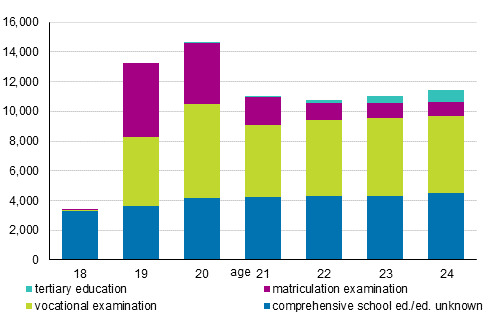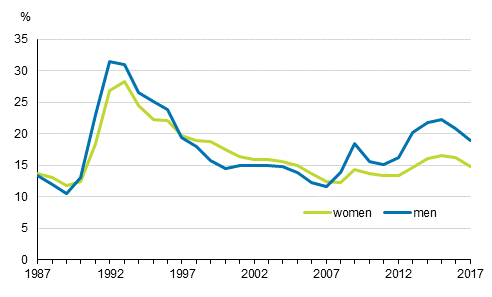Published: 12 February 2019
Majority of young adults outside work and education had at least upper secondary qualifications
According to Statistics Finland's employment statistics, around two-thirds of persons aged 18 to 24 outside work and education in 2017 had completed at least upper secondary level qualifications. In all, 37.6 per cent of the group had only comprehensive school education. The period of transition from upper secondary general school or vocational education to tertiary education is also visible in the variation of the number of persons outside work and education at around the age of 20.
Number of persons aged 18 to 24 outside work and education by age and highest completed qualification in 2017

Statistics Finland's employment statistics describe the main type of activity of the population, or the quality of economic activity at the end of the year. In the 2017 population, there were around 448,000 persons aged 18 to 24, of whom 50.3 per cent were employed, 31.2 per cent students, and 1.7 per cent conscripts. In the age group in question, 75,515 persons (16.9%) were outside work and education 1) . Of them, 43,342 were men (57.4%) and 32,173 women.
Good one third of young adults outside work and education rely on comprehensive school education
The majority of young adults outside work and education were 20 years old (14,615) and 19 years old (13,264). The number of persons having only basic level education 2) is fairly even in all age groups: Their number was lowest among 18-year-olds (3,270) and highest among 24-year-olds (4,511). In contrast, the number of those with vocational qualifications and especially those having passed the matriculation examination varied more depending on age. The number of persons with vocational qualifications outside work and education was highest among 20-year-olds (6,368). In turn, the number of persons with matriculation examination was biggest among those aged 19 years (4,963). The number of those with tertiary level qualifications 3) was low in the age groups examined: Highest among those aged 24 years (794).
The most typical educational background for those outside work and education varied by age. The share of persons with comprehensive school as the highest qualification was biggest among 18-year-olds (3,270 persons). In turn, among those aged 19, the most typical educational background was matriculation examination (4,963) and among those aged 20 to 24, vocational education qualifications (4,905 to 6,358).
Share of those outside work and education has remained in the 2000s clearly below the top years of recession in the 1990s
Share of men and women aged 18 to 24 outside work and education in the population of the corresponding age of the same gender in 1987 to 2017

Between 1987 and 2017, the number of persons outside work and education has varied from 441,800 to 505,800. The share of the group among all those aged 18 to 24 in the year concerned has been at its lowest in 1989 (11.2%) and at its highest in 1992 (29.7%). In 1992, the share of those outside work and education was at its highest in the regions of Lapland and Kainuu, where the share rose over 34.5 per cent. The share also rose to 33.9 per cent in Päijät-Häme in 1993.
In the examined period, there is greater variation in the shares of men outside work and education compared to women. During 1987 to 2017, the shares of persons aged 18 to 24 outside work and education in the same-age population varied for men between 10.5 and 31.4 per cent and for women between 11.9 and 28.3 per cent.
The shares of persons outside work and education were biggest among men and women during the economic downturn at the beginning of the 1990s and in the years after it (1991 to 1996). The differences between genders in the shares have also been greatest in the years after the economic downturn. From 1991 to 1996, the share of men outside work and education in all men of the same age was 1.7 to 4.6 percentage points higher than women's corresponding shares. In addition, the share of men outside work and education in all men of the corresponding age was 1.8 to 5.7 percentage points higher than women's corresponding shares between 2009 and 2015.
1) Persons performing military service are not included in persons outside work and education
2) The group of those with comprehensive school education includes all persons without information about qualifications after comprehensive school. They include persons having passed and persons having discontinued the comprehensive school and those whose educational background is unknown or who have completed a post-compulsory qualification abroad.
3) Tertiary level qualifications include all qualifications higher than upper secondary level qualifications, that is, lowest tertiary level, lower tertiary level and higher tertiary level degrees.
Source: Employment Statistics, Statistics Finland
Inquiries: Juhana Nordberg 029 551 3051, info@stat.fi
Director in charge: Jari Tarkoma
Publication in pdf-format (292.9 kB)
- Reviews
-
- 1. Economic dependency ratio was 137 in 2017 (12.2.2019)
- Tables
-
Tables in databases
Pick the data you need into tables, view the data as graphs, or download the data for your use.
Appendix tables
- Appendix table 1. The number of persons aged 18 to 24 outside work and education by age and highest completed qualification in 2017 1) (12.2.2019)
- Appendix table 2. The number of persons aged 18 to 24 outside work and education by sex and age in 2017 1) (12.2.2019)
- Appendix table 3. The number and share of persons aged 18 to 24 outside work and education in the population of the corresponding age by sex and year in 1987 to 2017 1) (12.2.2019)
- Appendix table 4. The number and share of persons aged 18 to 24 outside work and education in the population of the corresponding age by sex and region in 2017 1) (12.2.2019)
Updated 12.2.2019
Official Statistics of Finland (OSF):
Employment [e-publication].
ISSN=2323-6825. profession and socio economic position 2017. Helsinki: Statistics Finland [referred: 19.12.2025].
Access method: http://stat.fi/til/tyokay/2017/01/tyokay_2017_01_2019-02-12_tie_001_en.html

